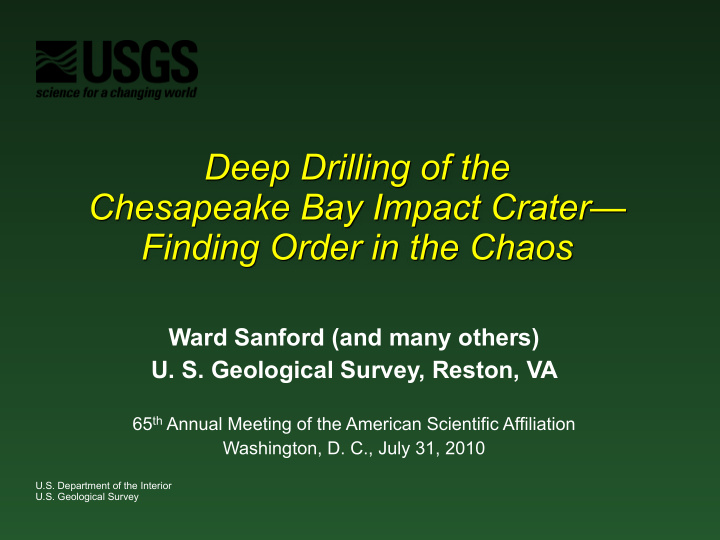



Deep Drilling of the Chesapeake Bay Impact Crater— Finding Order in the Chaos Ward Sanford (and many others) U. S. Geological Survey, Reston, VA 65 th Annual Meeting of the American Scientific Affiliation Washington, D. C., July 31, 2010 U.S. Department of the Interior U.S. Geological Survey
2
Funding Agencies (Drilling Costs) • International Continental Scientific Drilling Program, ICDP, (13-country consortium) • USGS • Geologic Discipline Program • Water Resources Discipline Program • USGS – Eastern Region Office • NASA Science Mission Directorate • Final Total Cost – $1.5 million 3
Pilot Hole: Sanford and others, 2004, Drilling the central crater of the Chesapeake Bay impact structure: A first look. EOS, vol 85, no. 39. 4
Delmarva Peninsula 30–Km Refraction/Reflection Line Velocity Model from Catchings et al., 2008, Journal of Geophysical Research, v. 113, B08413. 5
ICDP – USGS Drill Site Northampton County, Virginia 6
7
8
9
SAND !!!!! 10
11
12
13
14
15
Simulation of the Impact Collins, G. S., and Wunne- man K., 2005, How big was the Chesapeake Bay impact? Insight from numerical modeling: Geology, v. 3.., p. 925-298. Gohn et al., 2008, Deep Drilling into the Chesapeake Bay Impact Structure: Science, vol. 320, p. 1,740-1,745 16
Highlights of the Investigation • Crater stratigraphy—the sequence of deposition was documented • Post-impact stratigraphy—compared with rest of Atlantic Seaboard • Petrology—Shock features and impact melt rocks identified • Geophysics—seismic and gravity defined the crater’s size and shape • Paleontology—microfossils were “mixed” in the resurge deposits • Geothermal—vitrinite reflectance used to reconstruct thermal history • Hydrology—pore water chemistry documented brines and water “age” • Microbiology—craters are thought to host deep “early” microbe communities 17
Regional Stratigraphy above the Chesapeake Crater 18
19
Advection and Diffusion with Salinity and Sedimentation History 1800 Post- Impact Sediment 1350 s Exmore Diamicton Sedime 900 nt Blocks simulated simulated Granit observed observed e 450 Block( Suevit s) e Crystalli ne 0 Blocks Geology 0 10 20 Initial Chloride in crater = 42 gm/L 30 40 -5 -4 -3 -2 -1 0 D m = 3x10 -11 m 2 /sec 20 Chloride, in gm/L del O-18, in per mil Initial Oxygen-18 in crater = -0.75 per mil Total compaction = 100 m
All First Results published in 2009 • Gohn , Koeberl, Miller, and Reimold (editors), 2009, The ICDP-USGS deep drilling project in the Chesapeake Bay Impact Structure: Results from the Eyreville Core Holes. Geological Society of America Special Paper no. 458, 975 pages. 21
The Theology of Asteroid Impacts • Deposition of sediment can be very, very rapid (but can also be very, very slow) • Did God control large asteroids to create specific impacts? • Did God “deliberately allow” the impacts to happen. • Did God “bury treasure” for his children to find and study? 22
Recommend
More recommend